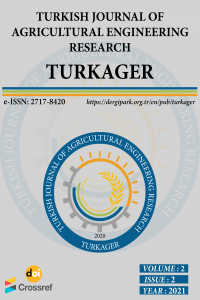Abstract
This study was conducted to evaluate the effect of rotor speed and screen size on power consumed during milling operation. The milling system was tested using three fish feed ingredients; bone meal, groundnut cake and maize. The moisture contents of the ingredients bought from the market are 13.1%, 14.7% and 17.5% dry basis, respectively. The milling machine was evaluated with the 3 kg of each feed ingredient and was replicated three times for each of the experimental parameters. The machine parameters varied during the experiment includes four screen sizes (1.5 mm, 2.0 mm, 2.5 mm and 3.0 mm) and five rotor speeds (1500 rpm, 1800 rpm, 2100 rpm, 2400 rpm and 2700 rpm). Regression analysis was carried out on the data collated. The analysis was used to develop a model which is capable of predicting the electrical energy (kJ) consumed. There was no significant effect of screen size on the average power consumed during milling since there is no linear relationship between power consumed and screen size. However, there is a significant effect of speed on average power consumed, the power consumed increases as speed decreases therefore making milling operation at higher speed to be cost effective since it doesn’t require much power to achieve the required output. The P-Value depicts that screen size has no significant effect on the electrical energy consumed during the milling operation while speed has a significant effect on the electrical energy used at 95% confidence level.
Supporting Institution
Nil
Project Number
Nil
Thanks
Nil
References
- Adeomaya SO and Samuel OD (2014). Design and development of a petrol-powered hammer mill for rural Nigerian farmers. Journal of Energy Technologies and Policy, 4(4): 65-74.
- Aderemi AM, Adedipe JO, Aluko KA, Odetoyinbo AP and Raji AA (2020). Development of a multi seed pneumatic cleaner. Journal of Multidisciplinary Engineering Science and Technology, 7(9): 12617-12624.
- Chambliss CG (2002). Forage moisture content testing. AG-181. University of Florida cooperative extension service, University of Florida, Gainesville.
- Donnel H (1983). Farm power and machinery. McGraw Hill, New Delhi, India. Anon. 1980. Encyclopedia Britanica, Vol. 21, pp.1157-72. William Benton, Chicago, IL, USA.
- Norazatul HM, Nyuk LC and Yusof YA (2015). Grinding characteristics of Asian originated peanuts (Arachis hypogaea L.) and specific energy consumption during ultra-high-speed grinding for natural peanut butter production. Journal of Food Engineering, 152: 1-7.
- Ovie SO and Eze SS (2013). Lysine requirement and its effect on the body composition of Oreochromis Niloticus fingerlings. Journal of Fisheries and Aquatic Science, 8: 94-100.
- Pyarelal SP, Swapnil CW, Gaurav RD, Akash GC, Vogita DK and Shradh HB (2017). Deshelling of “Semecarpus anacardium” (Bibba Seed): A review study. International Journal of Advance Research and Innovative Ideas in Education, 3(2): 1432-1439.
- Udo IU and Umoren UE (2011). Nutritional evaluation of some locally available ingredients uses for least-cost ration formulation for African Catfish (Claris gariepinus) in Nigeria. Asian Journal of Agricultural Research, 5: 164-175.
Abstract
Project Number
Nil
References
- Adeomaya SO and Samuel OD (2014). Design and development of a petrol-powered hammer mill for rural Nigerian farmers. Journal of Energy Technologies and Policy, 4(4): 65-74.
- Aderemi AM, Adedipe JO, Aluko KA, Odetoyinbo AP and Raji AA (2020). Development of a multi seed pneumatic cleaner. Journal of Multidisciplinary Engineering Science and Technology, 7(9): 12617-12624.
- Chambliss CG (2002). Forage moisture content testing. AG-181. University of Florida cooperative extension service, University of Florida, Gainesville.
- Donnel H (1983). Farm power and machinery. McGraw Hill, New Delhi, India. Anon. 1980. Encyclopedia Britanica, Vol. 21, pp.1157-72. William Benton, Chicago, IL, USA.
- Norazatul HM, Nyuk LC and Yusof YA (2015). Grinding characteristics of Asian originated peanuts (Arachis hypogaea L.) and specific energy consumption during ultra-high-speed grinding for natural peanut butter production. Journal of Food Engineering, 152: 1-7.
- Ovie SO and Eze SS (2013). Lysine requirement and its effect on the body composition of Oreochromis Niloticus fingerlings. Journal of Fisheries and Aquatic Science, 8: 94-100.
- Pyarelal SP, Swapnil CW, Gaurav RD, Akash GC, Vogita DK and Shradh HB (2017). Deshelling of “Semecarpus anacardium” (Bibba Seed): A review study. International Journal of Advance Research and Innovative Ideas in Education, 3(2): 1432-1439.
- Udo IU and Umoren UE (2011). Nutritional evaluation of some locally available ingredients uses for least-cost ration formulation for African Catfish (Claris gariepinus) in Nigeria. Asian Journal of Agricultural Research, 5: 164-175.
Details
| Primary Language | English |
|---|---|
| Subjects | Agricultural Engineering |
| Journal Section | Research Articles |
| Authors | |
| Project Number | Nil |
| Publication Date | December 31, 2021 |
| Submission Date | December 4, 2020 |
| Acceptance Date | January 29, 2021 |
| Published in Issue | Year 2021 Volume: 2 Issue: 2 |
International peer double-blind reviewed journal


